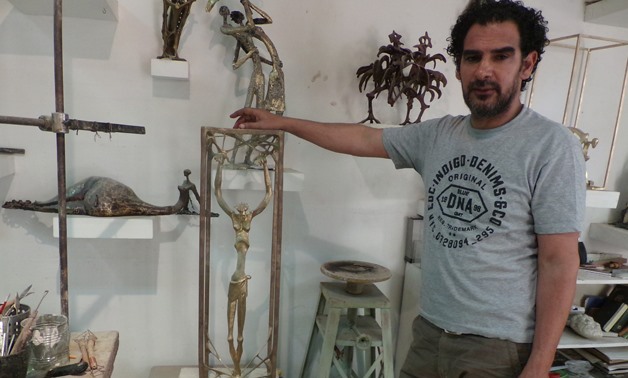
Jesus Taut - the crucified Jesus is a theme handled by many, Nathan made it taut as a link between earth and heaven
The sculptor in ancient Egypt was the gods’ maker—nowadays, not so much. “Sculpture has been suffering in Egypt for the past few decades,” says artist Nathan Doss. The fact that a certain percentage of the society considers statues a replica of ancient idols once worshiped by the heathens makes the attack on this form of art a fierce one, explains Doss, who has decided to fight back with his own body of work showcasing his thoughts and beliefs inspired by the Bible, his understanding of the human soul, the political reality that we live in and Egypt’s natural environment.
While some artists adopt the position of not explaining their work or art to the public, maintaining that every individual should understand what he or she wants, Doss believes the exact opposite. “This position is a kind of unjustified superiority,” he argues, explaining that his pieces are for the layman just as much as they are for the art connoisseur.
Born in 1971 in the Upper Egyptian city of Malawi in Minya, Doss graduated from the sculpture department of Minya University’s Faculty of Fine Arts in 1993. He then moved to Cairo to pursue his career in the arts. The artist’s work is internationally recognized and many of his pieces were selected by the Ministry of Culture to represent Egypt in various exhibitions.
Doss chose his atelier in the area behind the Mosque of Amr Ibn El-Aas in Old Cairo when, in 1997, the Ministry of Culture in cooperation with the Italian government adopted a project to develop that area and provide workshops to artists there.
For the past 10 years Doss has used granite, basalt, quartzite and marble following the ancient Egyptian tradition. “The West was not able to use these materials in the same way that ancient Egyptian sculptors have,” observes Doss.
These rocks are found all over Egypt’s natural habitat and were used to build temples, obelisks and statues. Doss continues the tradition but adds a contemporary touch; his portrait of Cleopatra, for example, is that of an Egyptian peasant. The image combines the goddess Isis with the famous queen to look like any Egyptian woman.
Four years ago Doss shifted to bronze. Since then he has succeeded in developing his own unique style, demonstrating a freedom of form without sacrificing any of the meticulous details involved in transforming the wax model into a finished bronze piece.
Doss follows what is called the “lost wax technique,” also known as the method of metal-casting in which a molten metal is poured into a mold that has been created by means of a wax model. Once the mold is made, the wax model is melted and drained away.
Determined to spread his message and pass on his techniques, Doss has been giving sculpture courses for the last three years, and has already taught 50 students. He likes to keep his classes small, with never more than 10 students in one course.
This past year Doss has managed to advocate for his art even further, holding a monthly artistic salon for artists from different backgrounds at his home on Geziret El-Dahab. It all started when his wife posted pictures of their country-style house on Facebook.
The Doss home is built in the traditional Upper Egyptian style and uses organic materials, shying away from anything processed like plastic and embracing the environmental and cultural elements of the island and Upper Egypt, where Doss grew up. “The reaction was overwhelming and many people loved the idea of a country-style house,” Doss says.
Seven months ago the small family decided to set up an artistic get-together the last Friday of every month, inviting portrait artists, sculptors, photographers, musicians and friends.
The art fest is a day-long visit, where statues of clay are made for guests, portraits are drawn, food is served within view of the Nile and music is played. Doss invites a different crowd every time in an attempt to reach out to as many people as possible.
“The idea of interactive art gives more value to the salon where the talents are shown and the crowd understand more about the artist’s work,” says Doss who plans to keep hosting the salons at his home.
 Nathan at work - forming the statue with wax
Nathan at work - forming the statue with wax
 Cleopatra, Isis, contemporary woman
Cleopatra, Isis, contemporary woman
 The Wailers after the Maspero massacre [involvement in the political arena]
The Wailers after the Maspero massacre [involvement in the political arena]
 The space and the freedom of form
The space and the freedom of form





Comments
Leave a Comment